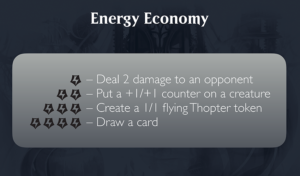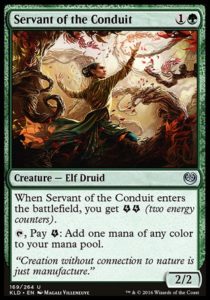This weekend, Seth Manfield continued to prove that he’s one of the greatest Magic players in the world, piloting Sultai Energy to a first place finish at Pro Tour Ixalan. His deck is centered around Energy, perhaps the most powerful mechanic in the blisteringly powerful Kaladesh block, which was the victim of an unprecedented three separate bannings. Today, let’s take a look at Energy. Where did it come from? Why is it so powerful? And can it be properly balanced?
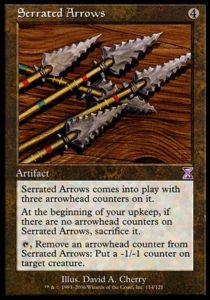
Mechanic E
Once upon a time, readers of Mark Rosewater’s articles heard of an unused mechanic that Rosewater had created years prior and was hoping to one day get into a set. During Kaladesh spoilers, he shared the history of Mechanic E, which finally saw print as Energy.
The design concept of Energy is simple. Instead of having individual artifacts with a finite number of charges, they shared their charges. You could use one artifact to recharge another one. Less powerful cards could be used to fuel more powerful effects. It’s a very neat concept, and an excellent fit for a world of inventors.
It is here we encounter the first danger of Energy: it’s an alternate resource. Just how good it is is an unknown, since it isn’t directly comparable to the existing resources of cards, life, and mana. Furthermore, because it is shared across different cards, it looks a whole lot like a resource transmutation mechanic. Some of the most powerful cards in Magic’s history efficiently turn one resource type into another—Necropotence and Channel being the most egregious examples. Lastly, it’s a resource that cannot be interacted with outside of niche cards like Solemnity, Harsh Mentor, or Tocatli Honor Guard. This isn’t a problem in and of itself (land destruction is miserable when widespread or powerful), but it means where Energy proves powerful, there are few safety valves to stop it.
Liquidity
The picture above is Wizards’ guide for the approximate value an energy counter should provide. Energy has seen a lot of tweaks and balancing, but a lot of Wizard’s economy has proven true: this is the amount of value you receive per expenditure of Energy, particularly 1-3 Energy. A little bit of Energy isn’t worth a card, and a lot of Energy is. Anything that produces 1-2 Energy is providing a fraction of a card’s value, so it can go an a card that’s slightly underpowered for its mana cost.
Here, we meet the fourth danger of Energy: it is completely liquid. Energy is shared among all cards, so a card costed to produce only a small benefit can provide a much more dramatic one when combined with another. Energy has no restrictions on its use, so as long you have at least one outlet for your Energy (with a minimal or no mana cost), you can spend all of your Energy immediately, or wait until the perfect moment. This is quite different from mana, which is limited to one use per turn and cannot be stored across turns.
All fine designs, on their own
Most cards with Energy are perfectly fine on their own, without any external Energy sources. Servant of the Conduit is a Utopia Tree with reasonable stats, but is restricted to two uses. Longtusk Cub is a slith Bear. Harnessed Lightning is a Burn the Impure. Glint-Sleeve Siphoner is a slow-tripping Deranged Whelp. Attune with Aether is Lay of the Land with minor utility. Aether Chaser is a solid aggressive creature with a little bonus following behind.
Some Energy cards have to be decent on their own, otherwise Energy is a completely parasitic mechanic on a bunch of weak cards that need each other in order to do anything. And herein lies problem five: cards that are already good without any external Energy sources may be too good with external support. This is perhaps the most egregious problem of Energy cards.
Longtusk Cub snowballs on its own in Limited, but when it can “haste” the Energy counters of Whirler Virtuoso, produce free value with Attune with Aether, or transmute the unnecessary mana from Servant of the Counduit, it becomes a Constructed powerhouse.
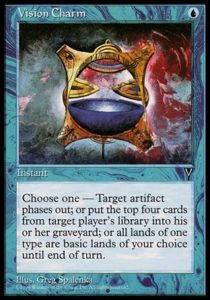 Small Things
Small Things
Once upon a time, Magic created charms. These popular modal spells featured effects too weak to be worth a single mana. Every card has to cost a whole number amount of mana, so adding some power to a card entails an increased mana cost, a stricter color requirement, a downside, or no change and a strict increase in power. Energy is perhaps the greatest tool Magic has ever created for allowing effective fractional increases in cost or power.
Consider Lay of the Land. It’s a rather weak card and could do with some more effect. However, you can’t just slap “draw a card” onto it—that effect is worth two mana (and Krosan Tusker is a fine card). You can’t just put it on a creature—Sylvan Ranger is solid at two mana. It’s hard to find a fractional benefit that won’t increase its mana cost. However, if you slap two Energy on it—which it can’t even use—you get Attune with Aether, one of the most powerful cards in Standard.
And thus we arrive at the final and most pernicious problem with Energy: fractions of cards add up. Attune with Aether is costed to provide you a tiny effect, one worth less than a card. That’s what almost every Energy producer does. The problem is that because Energy is liquid, you can combine these fractional cards to produce a full card’s worth of value. Because you can transmute one intended use of energy (say producing mana or killing a creature) into another (+1/+1 counters or thopter tokens), you not only effectively draw a card, you have say in what card you draw and when you get it.
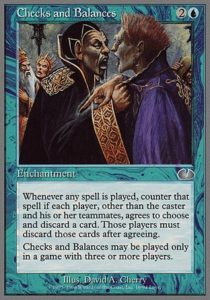 Walking the tightrope
Walking the tightrope
I believe Kaladesh block had some brilliant design concepts which are deeply difficult to balance. Development had an extremely challenging job, leading to a series of mistakes in Energy and Vehicles (as well as Aetherworks Marvel and Felidar Guardian, which are mistakes of a different kind). Energy is really hard to get right—put it on cards too weak without external support and it looks bad and only works in extremely parasitic decks. Put it on cards that are fine on their own and you have a flexible, parasitic, alternate resource with no usage limitations that allows players to choose what their cards do. This creates massive (potentially onerous) decision trees for players and power buffs for unassuming cards.
Kaladesh is just over halfway through its lifecycle and continues to dominate Standard with little support or impediment from other blocks. I expect to see Energy again in several years’ time and for it to be far more muted in its return, but perhaps with enough tools to reshape nonrotating formats as Oath of the Gatewatch’s Eldrazi did. I applaud Wizards for continuing to push the envelope and take risks, though Energy ended up far more powerful and dominant than intended.
And, as always, thanks for reading.
—Zachary Barash
Zachary Barash is a New York City-based game designer. He works for Kingdom Death: Monster, has an MFA in Game Design from NYU, and does freelance game design.
His favorite card of the month is Moment of Heroism. This unassuming little pump spell looks lackluster (after all, we get +2/+2 combat tricks with upside for W these days), but it can lead to complete blowouts in combat, where you kill a creature and gain 3-5 life for only two mana. It was particularly good in Innistrad, where instant-speed removal was weak and the (second) best deck in the format was an aggro deck overloaded on two drops. Sometimes, you just cast it to gain 5 life and flip the race on your opponent. It’s a delightfully simple card that beginners can understand, but it has powerful enough upside that skilled players can seek to maximize its effectiveness (while also siding it out when it’s irrelevant). That’s a whole lot to pack into a common combat trick with only two lines of text.


